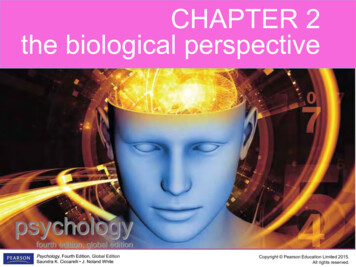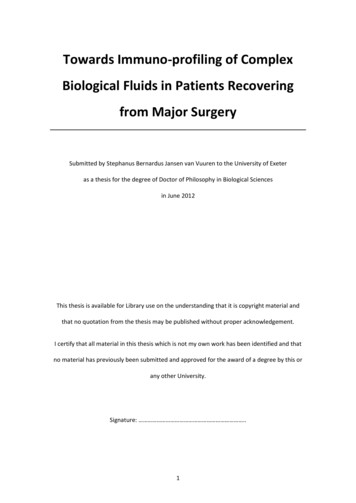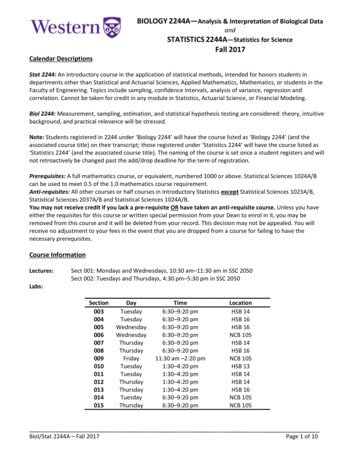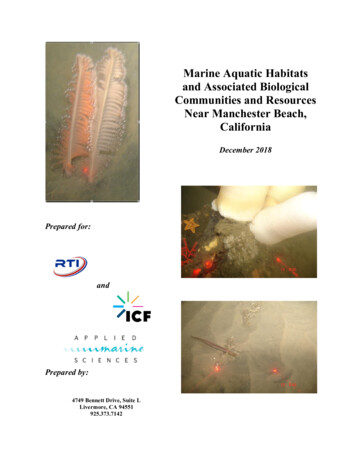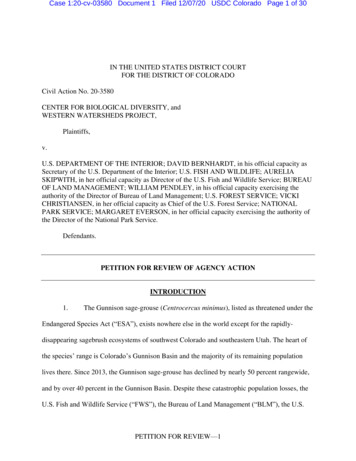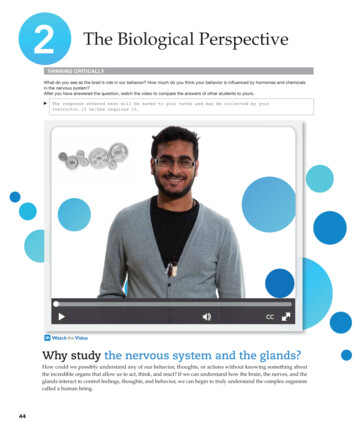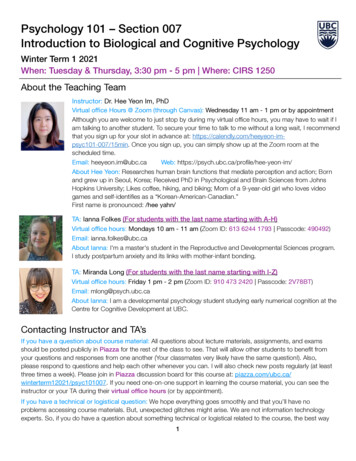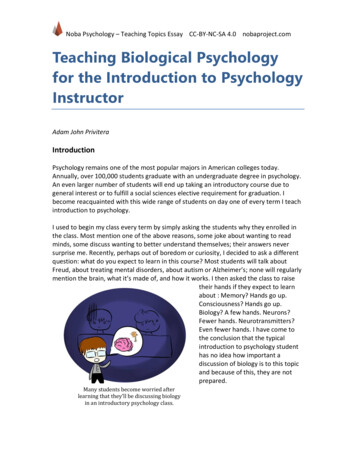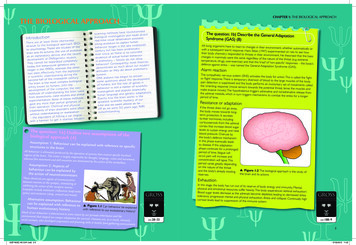
Transcription
CHAPTER 1: THE BIOLOGICAL APPROACHTHE BIOLOGICAL APPROACHIntroductionee intertwinedThere are at least thrical approach (BIO)logstrands to the bioare studies of theto psychology. Thesethe use of evolutionbrain and its actions,e, and the recentas an explanatory devicenetic studies.development of DNA/ged completelyThey cannot be separatgenetics onlytoday, but behaviouralereas the otherbegan in the 1990s, whm the explosionfroelytwo date effectivding during thein scientific understaneteenth century.second half of the nincomplex biologicalThe brain is the most. Until theentity known to humansuter, the mainmpcotheofdevelopmentgdin the brain camemethods of understanstudies and animalfrom dissections, caseof these methodsexperimentation. Nonertial glimpses ofgave any more than paical and physicalbrain operation. Chemorders were oftentreatments of brain disor explanationwithout understandingting a car engine– the equivalent of hitit started. Modernwith a hammer to gete revolutionisedscanning methods havand made directbiological investigationtion possible.real-time visual observahumanlainUsing evolution to expnineteenthelatthebehaviour began inproblematiccentury but has beenno concreteever since, as there isbehaviouranevidence of actual humnot showdosilsin prehistory – fosst theoriesmoy,ntlueeqnsbehaviour! Cotabou our moderndemonstrate as muchout prehistoricabattitudes as they dohumans.n to answerDNA analysis has begut the developmentsome questions aboue of genes inof humans, but the rolr of scientificttemaabehaviour is stillte (especiallyinvestigation and dispunetic adaptation).human language and gerks is thewoExactly how the brainry of ourstemycgreatest scientifias fartosalmemsetime and weo, fMRIagarsye50reweoff as wenotwithstanding.The question: 1a) Outline two assumptions of thebiological approach (4)Assumption 1: Behaviour canbe explained with reference tospecificstructures in the brainAll behaviour is ultimately produced by the operation of systems that connect specific localisedregions of the brain. The cortex islargely responsible for thought, language, vision and movement,whereas fine movement and skillexecution are dominated by the action of the cerebellum.Assumption 2: Aspects ofbehaviour can be explained bythe action of neurotransmittersThese chemicals are agents of communicationbetween neurons at the synapse,stimulating orinhibiting the action of the receptive neuron.Examples include melatonin (influences sleep/wakecycles) and serotonin (sleep, arousal and mood).2GGP WJEC AS Ch01.indd 2-3All living organisms have to react to changes intheir environment, whether automatically orwith a subsequent learnt response. Hans Selye(1947) experimented on rats to see howtheir body chemistry responded to threats intheir environment. He theorised that the basicchanges in mammals were the same regardlessof the nature of the threat (e.g. extremetemperature, drugs, over-exercise) and that this‘triad’ of ‘non-specific’ responses – the body’sdefence against stress – was named the General Adaptation Syndrome (GAS).Alarm reactionThe sympathetic nervous system (SNS) activates the body for action. This is called the ‘fightor flight’ response. There is temporary diver sionof blood to the large muscles of the body,pain detection is suppressed and the body performs an involuntar y set of movements calledthe ‘orienting response’ (move sensors towardsthe potential threat, tense the muscles andmake evasive moves). The hypothalamus triggers adrenaline and noradrenaline release fromthe adrenal medulla, which in turn triggers mechanisms to combat the stress for a longerperiod of time.Resistance or adaptationIf the threat does not go away,the body moves towards longterm protection. It secretesfurther hormones, includingcorticosteroids from the adrenalcortex that increase blood sugarlevels to sustain energy and raiseblood pressure. Over use bythe body’s defence mechanismin this phase eventually leadsto disease. If this adaptationphase continues for a prolongedperiod of time, fatigue willoccur, pain will increase andconcentration will lapse. Thisperiod varies greatly dependingon the nature of the threatand the body’s already existing Figure 1.2 The biological approach is the study ofthe brain and its actionsreser ves.ExhaustionIn this stage, the body has run out of its reserve of body energy and immunity. Mental,physical and emotional resources suffer heavily.The body experiences ‘adrenal exhaustion’.Blood sugar levels decrease as the adrenals become depleted, leading to decreased stresstolerance, progressive mental and0101cal Gross n,GuphysiexhaustioAQA AillnesideASs andcollapse. Continually highcortisol levels lead to suppression of the immune systeBarking DogArtm.Alternative assumption: Behaviourcan be explained with referenceto Figure 1.1 Can behaviour be explainedhuman evolutionary historywith reference to our evolutionary history?Much of our behaviour is determined to some extent by our primateinheritance and theenvironment that shaped our unique adaptation for survival. Humansare, as a result, intenselysocial animals, who developed cooperative and planning skills in hostile food-gathering environments.The question: 1b) Describe the General AdaptationSyndrome (GAS) (8)pp.28–33pp.188–9307/02/2012 11:22
CHAPTER 1: THE BIOLOGICAL APPROACHThe question: 2) Describe how the biological approach hasbeen applied in either psychosurgery or chemotherapy (12)Psychosurgeryapproach isof the biologicalmain assumptioneference toThrethwin be explainedcarWhat is the mainouvihabeain.atthenctions of the brassumption of thstructures and fuicifecspch?ringbiological approaare based on alteogical therapiesolorder toBiinnonaitibrmpesuthHow does this asor functions ofesurctruysically orstphneralway, whetherlink with the gebehaviour in somegeanchaim of biologicalchemically.in the brain,therapies?alter structuressurgery aims tohoycorder toPsinofontal lobes,What is the aimecifically the frsprebehaviour asmoofnsaterwhddesirable pattuntepsychosurgery, anledeorraltetionsbiological assumpa consequence.?islink with thA process calleda long history.shayerrgsuhog a hole in theedure of Psycephining – cuttintrWhat is the procorngnianeptrsure – has beenintracranial prespsychosurgery?d is still anskull to relieve40,000 years, anlyibssporfodpractisetoday.l procedure usedemergency medicaMoniz noticedery was born whenModern psychosurged less anxietythat chimps showa research reportally severed.rgcortex was su icalntroefprethwhenusing a wire loopy this on humansholeHe went on to trontal lobe by arted into the frrveseor(leucotome) insevemored then rotated toin the skull, anepieces of lobe.lter Freeman broknced by Moniz, WadaneudcrInitially influeadseri1940s and populaewith him in theomy, using an icotucleethofniorsvet ofsbiouorerengdarough theven hammered th). Hemytobolopick inserted orlorbitathe brain (transtichestaeanlthe eye up intocaloe road’, withthn‘oisthddioftenes!tiseptic procedurand negligent anr, especiallycame very populaPsychosurgery bean estimatedWorld War, withafter the Second00 in the UK,017in the USA,esmitobolo00,040These proceduresroughout Europe.and many more thtroduction ofute due to the infell into disrepcal and legaland major politirsseliilquantrmajor1960s and 1970s.e USA during thethinesnglealchlocate preciseuses MRI scans torygeurosurneModernrnt away viaon. Areas are bu.areas to operateion (gamma knife)atdiing focused raeivssseobrfoelectrodes or ususedare successfullyngtieaThese operations,sioner (OCD), deprescompulsive disorde.assedisn’soinrkdisorders and Pa4GGP WJEC AS Ch01.indd 4-5ChemotherapyWhat is the mainassumption of thebiological approach?The main assumption of the biological approach isthat behaviour can be explained with reference tospecific structures and functions of the brain.How does this assumptionlink with the generalaim of biologicaltherapies?Biological therapies are based on alteringstructures or functions of the brain in order tochange behaviour in some way, whether physicallyorchemically.What is the aim ofchemotherapy, and whatbiological assumptionslink with this?Chemotherapy aims generally to alter the chemistryofthe brain, usually in transmission at the synapse.This changes the nature of a behaviour or emotiongoverned by the action of those neurons.What is the procedure ofchemotherapy?Psychotropic (mind-changing) drugs are classifiedaccording to their target behaviours; the maingroupings are of drugs to tackle anxiety–baseddisorders, depression, and psychotic conditionssuchas schizophrenia.Anxiolytics reduce anxiety, and since they tendtocalm patients are also known as minor tranquillisers.In larger doses they have sedative effects (i.e.induce sleep) and they are also very addictive.There are many antidepressants, such as modifiedtricyclics, which have a variety of blockingeffects on various neurotransmitters or the enzymesthat break down the transmitters. SSRIs (specificserotonin reuptake inhibitors) are the more commondrug of choice today; they make more serotoninavailable at the synapse by blocking its reabsorption, and therefore lighten moods.Antipsychotics are also known as major tranquillisersand are used to treat the unusual (or positive)symptoms of major disorders, such as hallucinations,delusions and psychomotor excitement.Delivery of drugs is either oralor by injection. Oral deliverygives slower absorption andrequires a higher dose due tolosses during digestion, but isa very flexible method; injectionrequires a second person, haspotential for infection, isinvasive, but is more effectivefor a smaller dosage. Figure 1.3 Psychosurgery aims to physically alter thestructure of the brainpp.725–8507/02/2012 11:22
CHAPTER 1: THE BIOLOGICAL APPROACHGGP WJEC AS Ch01.indd 6-7 Takes a long time(over 20 minutes) Participanthas to be fullycooperative andlie still! Very detailed and noradiation hazards Shows where activityis taking place butnot what activityspecificallyMRIHydrogen atoms are‘wobbled’ by magneticfields; differentdensities of tissuewobble differently;detectors providedetailed imagesBrain scanPETThe metabolism ofradioactive glucosein the brain isdetectedMaguire’s studyof London taxidrivers’ memoriespinpointed changesin the hippocampusfollowing extensiveroute learning (‘TheKnowledge’) Somewhat risky(radiation) Costly Shows which brainstructures are activeduring tasks Does nottarget specificstructures easily Detailed informationin real timeBrain scanRaine’s study ofbrain dysfunction inviolent criminals Can onlygive generalinformation aboutbrain activity Very useful formonitoring levelsand types ofconsciousnessSurface sensors onthe scalp detectelectrical currentscaused by chemicalchanges in the brain.These are recordableas waves of activity.EEGUsed extensivelyin sleep research(e.g. by Dement) tomonitor levels ofconsciousness Information aboutbehaviour in lifeis retrospectiveand subject todistortion or lackof relevant detail Highly reliable anddetailed informationfrom millions ofpost-mortems Person has to bedead, so cannotrespond! Has given most ofour informationabout structures inthe brainBrains of dead peopleare taken to piecesand structuresdetected and mapped.Damage to an areacan be linked to theperson’s behaviour inlife.Routine post-mortem(e.g. Broca’s studyof ‘Tan’) Validity issues asdata collection bythe researcher(s)may be distortedby theirhypotheses A starting pointfor all otherneurologicalinvestigations Reliability issues– findings have tobe repeated Provides a largeamount of informationDissectionpp.52–6A single person isstudied in depth,usually because somebrain damage hasoccurredEach strength and weakness should be explained using the Point –Explain – Example (PEE) structure.Maximum marks are obtained for: detailed and technically correct ‘Explain’ detailed and technically correct ‘Example’.Case studyMaximising the marksEXAMPLEl approach (6) BIO ignores everything except biological effects, andespecially ignores social causes of behaviour. Thisis a reductionist approach. As social animals, much ofour social behaviour is determined and influencedby other people, so to ignore these effects is to ignore amajor cause of behaviour. We can overrule ourbiology in some cases, for social and moral reasons. Forexample, instead of mating with any partner, whowe mate with is strongly influenced by culture, such aswhat is currently fashionable In BIO, individual differences are ignored and generalisations made about all humans in a way thatdiminishes and ignores the individual (called a ‘nomotheticapproach’). The person, their personality andwhat makes them unique is ignored. Individual body chemistry differences can mean totally differentresponses and behaviours – for example, for the same dosage of a drug. The tranquilliser Valium producesemotional disconnection in most patients, but violent ragefor some, when provoked. Unlike males, femalehormone cycles alter body chemistry and behaviour. Equally, gender differences do not mean automaticdifferences in behaviour.STRENGTHS03.17 Psychology AS for AQA (A)Barking Dog ArtFamous examplesinclude Phineas Gage(prefrontal lobesand personality), HM,Clive Wearing (severeamnesia)WEAKNESSES Figure 1.3 The biologicalapproach has enabled thedevelopment of important drugtherapiesThe question: 3b) Evaluate two weaknesses of the biologica6The question: 5) Explain and evaluate the methodology usedby the biological approach (12)DESCRIPTIONtific methods, BIO uses the scientific approach and scienrimental tests toexpeghproceeding from observations throuin a systematicoutdcarrieisgapplication of knowledge. Testinern brainModts.resulleway and repeated to provide reliabof the brainpartselocattoresearch uses scanning techniquesidentifiedhasrchreseaBrain.that function during specific tasksthenisledgeknowThisneurochemicals and their functions.ulotomy,capsassuchsationapplied – for example, in brain operand in chemotherapy with SSRIs.cially chemotherapy, BIO has provided physical therapies, espethe effects ofthat have been massively effective in treatingtreatment ofmental disease and psychological disorder. Drugto lead relativelymental disorder has enabled millions of peoplewith bipolarnormal lives. The use of lithium has helped thoseSSRIs such asdisorder to have controlled moods; the use oftranquillisersandn,essiodeprwithleProzac has helped peopmore normalhave enabled people with schizophrenia to leadlives, though with side effects.biological approach (6)METHODThe question: 3a) Evaluate two strengths of the707/02/2012 11:22
CHAPTER 2: THE BEHAVIOURIST APPROACHTHE BEHAVIOURIST APPROACHIntroductionteenthIn the late ninere severalweeerthycenturychology inpsapproaches toexperimentalexistence. Manyre looking atpsychologists wethe sensorythe operation ofory, and Freudemsystems and mhis particularwas developingd psychologybrand of appliemic approach)(the psychodynaeutic work .apthrough his therpsychologistsMany of theseinking aboutalso relied on thur as welltheir own behavio.(introspection)t approachThe behaviourisly from the wish(BEH) grew partlogy on theto model psychoes, partly fromphysical scienctrospectiona rejection of ine a basis foras too subjectiva little bit fromdpsychology, anfor wealth andWatson’s desireical startingstatus. Its histor presidentialn’spoint was WatsoAmericanethtosesdradsociationPsychological Astwo mainin 1915, and itsrs were Pavlov’stheoretical pillaciation ofsowork on the asnditioning)coalicssstimuli (clar’s work onand, later, Skinnetthe environmenhow changes inurge behaviooperate to chanoning).itind(operant corning theoryThe question: 1b) Describe the social leasionTheory 1 Social learning theory of aggrestwo animals, which may or may notAggression is a social transaction betweenanimal (and human) behaviour and ainvolve violence. It is a normal aspect oftory or possession of objects.major form of communication about territhe environment will stronglySocial learning theory (SLT) assumes thatobservation will take place.influence behaviour, and that learning byy) or model (do generallyHumans are predisposed to imitate (copreinforced by consequencessimilar behaviour). This behaviour is thenwill observe others using(operant conditioning). Therefore humansthat aggression in similaraggression successfully, and then imitatel (rewarded), the behaviour iscircumstances. If they are also successfug tried in different situationsreinforced and will continue, often bein(generalised).Theory 2The question: 1a) Outline twoassumptions of the behaviouristapproach (4)Assumption 1: Human behaviour is causedand influenced by events in our environmentalonenoBehaviourists see humans as born as blank slates, withthroughdcreateisiourbehavnpredetermined behaviours. Humacalclassi–nglearniofssesthe operation of the principal proceng.learnisocialandgconditioning, operant conditioninAlternative Assumption 1: Skinner’sassumption Figure 2.1 The behaviourist approach seeshumans as blank slates, with behaviours beinglearnt rather than innatebehaviourlabel as mental events are essentially fictions, and theRadical behaviourism assumes that the experiences wehts orthougions,intenttorserecouutin other ways – that is, withoattributed to them can be more effectively explainedism.organtheofiourenvironment and the behavplans, and making causal links between events in theAssumption 2: Psychologists should focus onto be scientificobservable, measurable events in orderred, they should not be included in scientificSince mental events cannot be directly observed or measut approach rejects self-reports and opinions.explanations of behaviour. Therefore the behaviourisAlternative assumptiong and operant conditioning as assumptions.WJEC also accepts descriptions of classical conditionint – Explain – Example), making sure there is aIf you wish to use these, follow the PEE method (Poinr.technically accurate ‘Explain’ at the core of your answe8GGP WJEC AS Ch02.indd 8-9of aggression (8)pp.15–17,38–9theory of aggressionBandura set out to demonstrate the SLT6 year s from theby taking 72 children aged between 3 andrated their naturalChicago University nursery. Having firstplay, he exposedaggression by observing them in normallt model inaduantotesminuthem individually for 10tly orquiedplayereitheela playroom. The adult modinflatable,e,thenpoly,largeaardsbehaved aggressively towin the USA).self-righting doll (known as a ‘Bobo doll’, and theyusedwereelsBoth male and female mode in theabusalverbandicalwere scripted to use physaggression conditions.nd roomThe children were then taken to a secoattractivewithplaytoedallownotwhere they were. It wastoys – this was to upset and arouse themrenthought that arousal would make the childely.essivaggrtreacmore likely toa ‘Bobo’The final room had attractive toys andwasroomdoll. The children’s behaviour in thatplingsamtes,observed and recorded for 20 minubehaviour ever y 5 seconds.iedBandura found that children largely copnonoreessivaggrthe behaviour of the model,thecopytolikelyaggressive. They were moremoretlyslighweresame-sex model and boysthemofyMan.girlslikely to be aggressive thanel to be slightlyfound the aggression of the female mod Figure 2.2 A bobo dolldisturbing.pp.557–9,455–62907/02/2012 15:19
CHAPTER 2: THE BEHAVIOURIST APPROACHThe question: 2) Describe how the behaviourist approach hasbeen applied in either systematic desensitisation or aversiontherapy (12)Systematic desensitisationWhat is the maineassumption of thoach?prapstrioubehaviHow does thiswithassumption linkofmthe general aiapies?erthlbehaviouraWhat is the aimof systematicdesensitisation,raland what behaviouwithnkliassumptionsthis?edureWhat is the procof systematicdesensitisation?isourist approachon of the behavisgeanchtoThe main assumptisponser is learnt in rethat all behaviout.in the environmenethat a maladaptivapies all assumeedshuingtiBehavioural therexordour can be altereng(problem) behavie based on ning a newlves classical colyThe therapy invous that previousion) to a stimul,a)bihoresponse (relaxat(pseonifiable fear resps.evoked an unjustpresence of birdetherovyetxianeemstrstexriouasvisuchon. Behasponse substitutiorntThis is called rerelearresponses can bebelieve that allques.nichtengniionditmodified using coess of systematicsteps to the procThere are threeof a phobia:desensitisationresponse in aarns a relaxatione therapist.1. The patient leercises led by thexngniaitrofseriesothers take aarn very quickly,letsentipameSolong time.tspatient construccontinuing, thewloomfr2. While this is,seonspe of phobic rea graduated scal) to extremepicture of a birda.isanxiety (e.gthe hand). Thisbird perched ony.aperanxiety (e.g. athindder of progressthen used as a laonthe lowest stepthen exposed to.seonspreon3. The patient isxatiactises the relasedpoexearthe ladder and preyth,lax consistentlyOnce they can rel of anxiety.veto the next leSuccess is judgedtion beingeither by relaxaachieved at themost extreme stepof the ladder, orwhen the patientjudges their lifeto be acceptablyimproved.Aversion therapyWhat is the maineassumption of thoach?prapstbehaviouriHow does thiswithassumption linkofmailranethe geapies?erthlraouvihabeofWhat is the aimaversion therapy,raland what behaviouwithnklisonassumpti?thisedureWhat is the procapy?of aversion therisourist approachon of the behaviangeschtoThe main assumptiseonsprer is learnt inthat all behaviout.enin the environmethat a maladaptivapies all assumeerthledrashouuivinghaBed or extiour can be altere(problem) behavibased on learningemmraogaining prby a suitable trprinciples.undesirablelves removing anThe therapy invore and alcohol)ulus (e.g. pleasuimstatoseonrespanother (e.g.e stimulus withby associating onclassicalre nausea) usingalcohol and seveconditioning.In the case ofalcohol, patientsneare given a salisolution withan emetic (drugto cause nauseaand vomiting).They are thengiven a glass ofwhisky, whichethey smell, tastk.and then drinIf vomiting doesnot occur, theythen get furtherwhisky and beerplus the emetic.Further repeatsinvolve a widercrange of alcoholiiouraln Figure 2.4 Aversion therapy, a behaveetwbeIndrinks.treat alcoholismtreatment, can be used totreatments, softdrinks aret develop toaversion does noprovided so thatof alcoholpromote the useall drinks and tosubstitutes.treat sexualuse has been toA controversialiring eroticpreferences by paorientation andwever, thisectric shocks; hopictures with ele 1970s,thedisused sinchas been largelydes.tutiatals in socifollowing changep.73510GGP WJEC AS Ch02.indd 10-11 Figure 2.3 Systematic desensitisation can beused to treat phobias1107/02/2012 15:19
CHAPTER 2: THE BEHAVIOURIST APPROACH12GGP WJEC AS Ch02.indd 12-13 Generally ecologicallyvalid Can inform furtherresearch Much information issubjective self-reportfrom participants Usually conducted veryethically Cannot achieve highlevels of control High levelsof qualitativeinformationIn-depth studyof a singleindividual,often typical oftherapiesCasestudiesWolpe’sdevelopmentof systematicdesensitisationvia study ofanimals andthen treatmentof anxietydisorders Ethical problem of fairtreatment – many tokeneconomy studies usedrewards that should bepart of normal life(e.g. cinema visits) High levels ofcontrol ensurevalid conclusionsabout cause-effectrelationships can bemade Ethical problem offreedom to leave thestudy Partly realisticsituations (ecologicalvalidity) Ethical problem ofconsent from patients orchildren Actual humanparticipantsHighlycontrolledstudies innaturalsettings,usually someform ofinstitutionwhereconsiderablebehaviouralcontrol isnormalToken economystudiesin mentalhospitals;Bandura’s studyof aggression inchildren Animal behaviour inunnatural circumstancesis abnormal can be harmed morethan humans do not have to consent Animals are not directanalogues for humans inmany behaviours (e.g.thoughts, sex) have fasterreproductive cycles Ethical concerns have ledto a huge reduction inanimal experiments are cheapAnimals:Pavlov’s useof dogs toinvestigatedigestion,leading to theinvestigation sEach strength and weakness should be explainedusing the Point – Explain – Example (PEE)structure.Maximum marks are obtained for: detailed and technically correct ‘Explain’ detailed and technically correct ‘Example’.Standardinvestigationof cause-effectrelationshipsusing highlycontrolled,laboratory-basedstudiesMaximising the marksAnimalexperimentsvityStrengthses not accept mental events as causes, although theyclearly can be. We candecide to do somethingwehaveneverdone before (e.g. takea chance on a new experience), andpeople can resist reinforcements and punishments purely foran idea they may have(e.g. resisting torture fora cause theybelieve in). A completepsychology has to account for someforms of mental eventsto be credible. BEH can offer no explanation at all of manyimportant humanbehaviours, such as creativity and humour. Creativity involvesproducing something that has not been done before in the sameway and is recognised byothers as unique and worthwhile insome way. Examples arefound in art and music.Behaviourismmay be able to point tothe acquisition of influences andskills (e.g. keyboard technique), but cannot show ho w theseactivities develop in total, because most of theunique Figure 2.5 The behaviactivities are thought proourist approach cancesses, and thus unobservable.offer no explanation forcreatiExampleThe question: 3b) Evaluateof the behaviourist appr two weaknessesoach (6) BEH doDescriptionur of others causes and BEH highlights the way the behavioour behaviour,aggression) and other people reinforceofingvia observation (e.g. social learnWe alsoing).itioncondrantof things we do (opesuch as parents approving or disapprovingumption andconsfoodeenbetwinternal states, such aslearn associations between objects andpleasure (classical conditioning).observable andof psychology by shifting the focus onto BEH emphasises the scientific naturemeasurable events.be true, accurate orle, not directly measurable, so may not Ideas and thoughts are only reportabhology if it is tomeasurable events can be used in psycreliable. To gain accurate knowledge, onlybe scientific in the same way as physics.The question: 5) Explain and evaluate the methodologyused by the behaviourist approach (12)Methodhs of the behaviouristThe question: 3a) Evaluate two strengtapproach (6)reinforces our behaviour. We learn1307/02/2012 15:19
CHAPTER 6: CORE STUDIES IN SOCIAL PSYCHOLOGYASCH (1955): OPINIONS AND SOCIALPRESSUREContext ch was a Polish immrigaras na socialt whoAsreeSolomon distinguished caryev.enceSAhad at in the U t came to promin atesisgloohcpsyestimy firsconformit exploring group antsnorkoWip2)jar. Partic afteress (193with Jenn er of beans in atsnemegmbjudof the nu conform in their imates.osttended t their individual e xperiment ongninsituationt ed a ediscuss) conduc . This is where a639(1freted inrmitySheribe interp es toldnal confouiootcaitrminfofor cluat is,ous – th We tend to lookuigbmaisy.n.n one wamore tha o make a decisio ect: a stationarytffeesuictleokinee, becausenabd the aut ill appear to mov 0 timesesufrie5Shmwome 20–dark roomoving s He asked particlylight in atnatsn).is coovementsmoved,the eyeaccadic m such a light had her(sdnoca sew farof otjudge hoowledgeipants to ually and with kn answers becameidoficiboth indiv sults. The rangewith part ge.rer’selet case,ratevlaaepeopphtuthe groower inmuch narr g to conform to ct that manydinfaepants ten terested in theunder thinseavrm e nbornAsch wfotnsocreettoinonants in thepeople d social pressure,emmove netcsneatgnissstrof rehistory ofrom ther.aWdWorlSecondCritical assessmentusnambiguowith an u therkowoided tlear toAsch dec e that is very c at normativeno,swouldto lookstimulue aimed ther participants , evenH.tnaipparticis whep normy, whichs a grouconformit ir answer toward therwise. This isoheity,change t ement told them type of conformgldujurfif theirre powe l judgement andmuch moaclearly a enial of a person hat is clearlytdgrminonirupreqgrouafoecnacceptaof.t degreeincorrect expect any grea articipants wouldottpHe did nthat mosy, ratheritrmfoncoconform.refuse tontrimeean expes’s jelly bsennJe6.1 FigureAimAsch aimed to test the strength ofnormative conformity by presentingparticipants with a group normregarding a physical judgement thatis clearly wrong.pp.401–228GGP WJEC AS Ch06.indd 28-29Perrin and Spencer (1980) suggested that theAsch effect was a ‘childtime’. They carried outof itsan exact replication oftheoriginal Asch experimenusing engineering, mathetmatics and chemistr y students as subjects. The reswere clear-cut: on onlyultsone out of 396 trials didan obser ver join the errmajority. They argue thaoneoust a cultural change hastaken place in the valueconformity and obedienplaced once and in the position ofstudents. In America instudents were unobtruthe 1950ssive members of society,whereas now they occuquestioning role. This impy a free,plies that Asch’s resultswere not generalisableculturally.crossNicholson et al. (1985)were more positive, finding that the number ofresponses obtained waerrors significantly lower thanthose repor ted by Asch, bualso significantly greatet it wasr than zero (12 out ofthe UK sample of 38 ansample of 21 conformedd 8 of the USat least once). British and American students didin their responses to unnot differanimous peer-group opinion. This provides some supfor Asch.portLalancette & Standing (1990) repeated the classic experiment and variatno conformity was obserions, yetved. They concluded that the Asch effect appearsunpredictable phenomto be anenon rather than a stabletendency of human behaviour.Neto (1995)repeated theclassic conformpsychology stity experimenudents in a Pot, using womenrtuguese univmajority grouper sity as mino, and control parityof one unanimrticipants. Theas similarly asousoriginal procepossible usingdua computer prre was re-enaexperimentalogram. Amongctedcondition, 59participant
e 1.3 The biological approach has enabled the development of important drug therapies pp.52–6 GGP WJEC AS Ch01.indd 6-7 07/02/2012 11:22. 8 9 CHAPTER 2: THE BEHAVIOURIST APPROACH y of aggression y not viour and a y or possession of o
